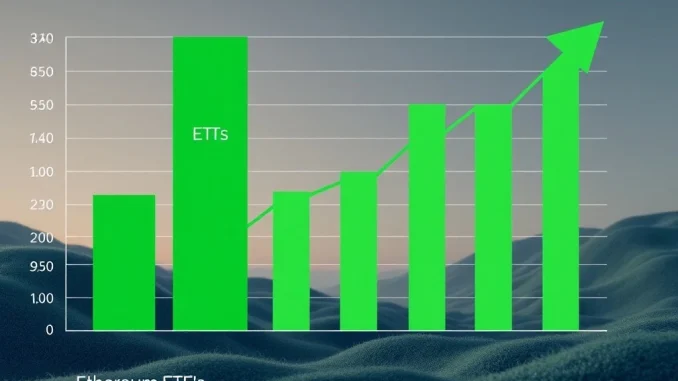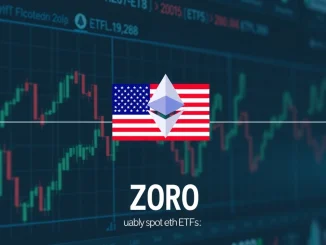
The cryptocurrency market is buzzing with exciting news! U.S. Spot Ethereum ETFs recently hit a remarkable milestone, recording a staggering $298.06 million in total net inflows on July 21st. This isn’t just a one-off event; it marks an impressive streak of 12 consecutive trading days of positive flows, signaling a growing appetite for institutional exposure to Ethereum. For anyone tracking the evolution of digital assets, this consistent influx of capital into Ethereum-backed products is a powerful indicator of shifting investor sentiment and increasing confidence in the second-largest cryptocurrency.
Spot Ethereum ETFs: A New Era of Investment
What exactly are Spot Ethereum ETFs, and why are these inflows so significant? Simply put, a spot Ethereum ETF holds actual Ethereum (ETH) as its underlying asset. This differs from futures ETFs, which track futures contracts. The approval of spot crypto ETFs in the U.S. has been a game-changer, opening the floodgates for traditional investors to gain exposure to cryptocurrencies without directly owning the digital assets themselves. This provides a regulated, accessible, and often more familiar investment vehicle for a broad range of market participants, from individual investors to large institutions.
The recent approval by the U.S. Securities and Exchange Commission (SEC) for these products has injected a new level of legitimacy and confidence into the crypto market. It suggests a maturing regulatory environment and a growing acceptance of digital assets within mainstream finance. The consistent positive flows underscore this shift, demonstrating that investors are keen to participate in Ethereum’s growth story through these regulated channels.
Understanding the Ethereum ETF Inflows Phenomenon
The $298.06 million net inflow on July 21st, as reported by Trader T on X, is a testament to robust investor interest. But the real story lies in the consistency: 12 consecutive days of positive Ethereum ETF inflows. This sustained demand points to more than just speculative trading; it suggests a fundamental shift in how large capital is approaching the Ethereum ecosystem.
Several factors likely contribute to this phenomenon:
- Regulatory Clarity: The SEC’s green light has significantly reduced uncertainty, making these products more attractive to risk-averse institutional investors.
- Ease of Access: ETFs trade on traditional stock exchanges, making them as easy to buy and sell as stocks, bypassing the complexities of direct crypto ownership.
- Diversification: Investors are increasingly looking to diversify their portfolios beyond traditional assets, and Ethereum offers a compelling growth narrative.
- Ethereum’s Ecosystem Growth: The ongoing development of the Ethereum network, its role in DeFi, NFTs, and Web3, continues to attract interest from a technological and investment perspective.
This sustained inflow trend is a strong bullish signal for Ethereum, indicating a deeper institutional embrace that could provide a more stable foundation for its price movements going forward.
Crypto ETF Performance: Who’s Leading the Pack?
While the overall net inflow figure is impressive, it’s insightful to look at the individual players driving this momentum. The competition among issuers to attract capital is intense, and the latest figures reveal clear leaders in terms of crypto ETF performance:
| ETF Name | Issuer | Net Inflow (July 21) |
|---|---|---|
| FETH | Fidelity | $126.93 million |
| ETHA | BlackRock | $102.70 million |
| Mini ETH | Grayscale | $54.90 million |
| ETHW | Bitwise | $13.15 million |
| CETH | ARK 21Shares | $0.37 million |
As the table illustrates, Fidelity and BlackRock are dominating the early stages of this race, together accounting for over $229 million of the day’s inflows. Grayscale, despite its smaller contribution compared to its Bitcoin ETF counterpart, still secured a significant portion.
Fidelity Ethereum ETF: A Major Player
Fidelity’s FETH led the pack with a substantial $126.93 million in inflows. This isn’t surprising given Fidelity’s long-standing reputation as a trusted financial services giant. Their established client base and expertise in traditional asset management likely give the Fidelity Ethereum ETF a significant advantage. Investors often gravitate towards familiar and reputable names, especially when venturing into newer asset classes like cryptocurrencies.
Fidelity’s commitment to the digital asset space, evidenced by its earlier Bitcoin ETF and other crypto-related initiatives, positions it as a key player in bridging the gap between traditional finance and the burgeoning crypto economy. Their strong performance indicates significant investor confidence in their offering and operational capabilities.
BlackRock Ethereum ETF: Impact and Outlook
Hot on Fidelity’s heels was BlackRock’s ETHA, pulling in an impressive $102.70 million. BlackRock, the world’s largest asset manager, brings unparalleled influence and a vast network of institutional clients to the crypto market. The success of the BlackRock Ethereum ETF is particularly noteworthy because it signals that even the most conservative corners of traditional finance are now seriously considering and allocating capital to digital assets.
BlackRock’s entry and strong performance in the Ethereum ETF space could catalyze even broader institutional adoption. Their stamp of approval, so to speak, often encourages other large funds and wealth managers to follow suit. This could lead to a domino effect, potentially driving further substantial inflows into the Ethereum ecosystem in the months and years to come.
What Does This Mean for the Ethereum Market?
The consistent positive inflows into U.S. spot Ethereum ETFs have several profound implications for the Ethereum market:
- Increased Demand: Each inflow means the ETF issuer is buying actual ETH to back the shares, creating direct buying pressure on the Ethereum price.
- Price Stability: Institutional buying can help stabilize prices and reduce volatility, as these investors tend to have longer-term horizons than retail traders.
- Mainstream Validation: The success of these ETFs further validates Ethereum as a legitimate investment asset, attracting even more interest from diverse investor segments.
- Market Maturation: It signifies a maturing market where regulated products provide a safer gateway for large capital, moving away from more speculative, unregulated avenues.
While past performance is not indicative of future results, the current trend paints a bullish picture for Ethereum’s integration into global financial markets.
Are There Any Challenges Ahead?
Despite the current euphoria, the path for Ethereum ETFs isn’t without potential hurdles:
- Regulatory Shifts: While the current environment is positive, future regulatory changes could impact the market.
- Market Volatility: Cryptocurrencies are inherently volatile, and while ETFs mitigate some risks, the underlying asset’s price fluctuations will still affect ETF performance.
- Competition: As more issuers enter the space, competition for investor capital will intensify, potentially impacting fees and market share.
- Global Economic Factors: Broader economic downturns or shifts in interest rates could affect investor appetite for riskier assets like crypto.
Monitoring these factors will be crucial for understanding the long-term trajectory of spot Ethereum ETFs.
Actionable Insights for Investors
For those looking at the Spot Ethereum ETFs market, here are some actionable insights:
- Research Each ETF: While the underlying asset is the same, fees, liquidity, and issuer reputation can vary.
- Understand Your Risk Tolerance: Even with ETFs, exposure to crypto means exposure to volatility.
- Consider Long-Term Trends: The 12-day streak suggests sustained interest, but short-term fluctuations are still possible.
- Stay Informed: Keep an eye on regulatory updates and market news that could impact these products.
The impressive net inflows into U.S. spot Ethereum ETFs mark a significant turning point for the cryptocurrency market. With over $298 million flowing in on July 21st alone, extending a 12-day streak of positive movements, it’s clear that institutional and retail interest in Ethereum is accelerating. Leading the charge are financial giants like Fidelity and BlackRock, whose substantial contributions highlight the growing confidence in Ethereum as a legitimate and valuable asset class. This surge in investment not only injects fresh capital but also signifies a maturing landscape where regulated products are paving the way for broader adoption. While challenges like market volatility remain, the consistent demand for these ETFs paints a powerfully optimistic picture for Ethereum’s future in the global financial ecosystem.
Frequently Asked Questions (FAQs)
Q1: What is a Spot Ethereum ETF?
A Spot Ethereum ETF is an exchange-traded fund that directly holds Ethereum (ETH) as its underlying asset. It allows investors to gain exposure to the price movements of Ethereum without having to buy, store, or manage the cryptocurrency directly.
Q2: Why are positive net inflows important for Ethereum ETFs?
Positive net inflows indicate that more money is flowing into the ETF than out of it. For a spot ETF, this means the issuer is purchasing more of the underlying asset (Ethereum), creating buying pressure on the market and signaling strong investor demand and confidence.
Q3: Which U.S. Spot Ethereum ETFs are currently seeing the most inflows?
As of July 21st, Fidelity’s FETH led with $126.93 million in inflows, followed closely by BlackRock’s ETHA with $102.70 million, and Grayscale’s Mini ETH with $54.90 million.
Q4: What does the 12-day streak of positive inflows signify?
The 12-day streak of positive inflows signifies sustained and consistent institutional and retail interest in Ethereum through regulated investment vehicles. It suggests a deeper, more fundamental shift in investment strategy rather than just short-term speculation, indicating growing long-term confidence in Ethereum.
Q5: How do Spot Ethereum ETFs differ from Ethereum futures ETFs?
Spot Ethereum ETFs hold actual Ethereum, reflecting its current market price. Ethereum futures ETFs, on the other hand, hold futures contracts that bet on Ethereum’s future price, meaning they don’t directly hold the cryptocurrency itself and their performance can differ from the spot price.
Q6: Is investing in Spot Ethereum ETFs safe?
While Spot Ethereum ETFs offer a regulated and more accessible way to invest in Ethereum compared to direct ownership, they are still subject to the inherent volatility of the cryptocurrency market. Investors should assess their risk tolerance and understand that the value of the ETF can fluctuate significantly.



